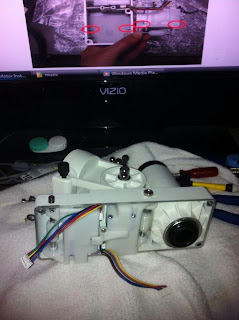I ordered a shoulderless c-mount nosepiece from OPT and had it in my head that in order to facilitate the new nosepiece that I would have to remove the c/cs adapter ring from the camera housing. Apparently in the past, these little guys just unscrewed from the housing, but modern incarnations have two set screws holding the adapter ring in place. This is important because while researching this I found tons of posts saying that you had to remove the adapter, but none mentioned anything about the setscrews. Users at the Solarchat forum got me squared away on the info and one screw came out without issue. The other woudn't bite (it was a regular type screw needing a tiny blade type screwdriver, but half the head was missing and the blade tip couldnt bite). I tried drilling it out to no avail. I attempted to remove the ring with pliers, but I only got it about three revolutions before irreversibly locking. After much stress and heartache, I accepted that the adapter ring would never be removed. As it turned out, the new nosepiece came in and it threaded right into the small thread. Guess it didn't need to come out after all, which is a good thing.
I didn't have a vice at the house, and let me tell you that trimming the nosepiece with a hacksaw was a short. I got it done though, and despite the fact that it is ugly as hell, it does work nicely.
Here are today's results: Setup is DMK41 and stock PST on a SmartEQ mount. 1539UT / composite for proms and disk detail..
As you can imagine, I am very happy. The DMK41 performed as expected, nothing to note against the past performance of my old DMK21. Barlowed images do have the occasional newton rings, but usually they can be dealt with. Not bad despite the PST being one of the most difficult scopes to image with.

























